DOODLEBUG
Those people who knew “Jack” Schweigert associate both him and his wife Ann with their shop in Roscommon, Michigan. Not everyone is aware of the fact that prior to that, he owned and operated his first shop in Luzerne, Michigan some 15+ miles east of Grayling, Michigan. This first shop was there for about 10 years. It was here that Jack acquired a reputation as an excellent fisherman, tier and Au Sable River guide.
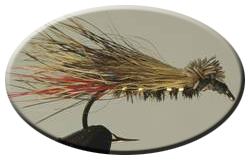
Materials:
Hook: Mustad #94840 Sizes: 8-10
Thread: Black, 6/0
Tail: Red Hackle Fibers
Underbody: Yellow, Wool Yarn
Overbody: Peacock Herl
Rib: Fine Gold Tinsel
Wing: Woodchuck Body Hair
Hackle (crown): Deer Body Hair, shaped and trimmed into a top-knot.
Over the years Jack may have developed other famous flies, if so, they’ve been lost to the annals of time. This pattern has not been available in shops for many years. I still fish with it and have found it to be an extremely effective pattern. It has proven to be a fly worthy enough to be one of my “go to flies” when there are no insects on the water. It holds a place of prominence in my fly box.
Jack’s Doodlebug can be fished either dry or wet and works on rivers, streams and ponds. Fast water or still, this is a great fly. Jack originally designed this fly as an attractor pattern to be used when there are no insects on the water. Trust me it works! Jack developed this fly while in his original shop in Luzerne, Michigan. I’m told that Jack spent many hours fishing this fly on both Luzerne Pond and Pretty Lake as well as the Au Sable River.
 Tie in a good base of thread, the full length of the hook.
Tie in a good base of thread, the full length of the hook.
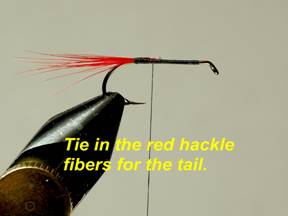 Tie in the red hackle fibers for the tail.
Tie in the red hackle fibers for the tail.
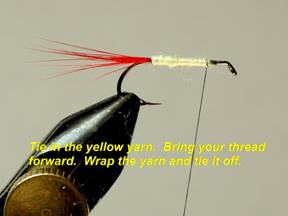 Tie in the yellow yarn. Bring your thread forward. Wrap the yarn and tie it off.
Tie in the yellow yarn. Bring your thread forward. Wrap the yarn and tie it off.
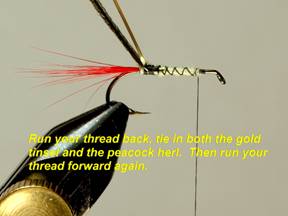 Run your thread back, tie in both the gold tinsel and the peacock herl. THen run your thread forward again.
Run your thread back, tie in both the gold tinsel and the peacock herl. THen run your thread forward again.
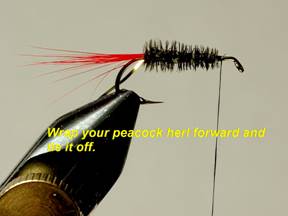 Wrap your peacock herl forward and tie it off.
Wrap your peacock herl forward and tie it off.
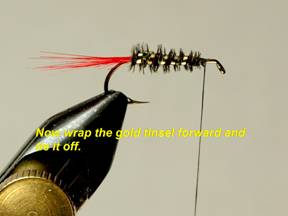 Now wrap the gold tinsel forward and tie it off.
Now wrap the gold tinsel forward and tie it off.
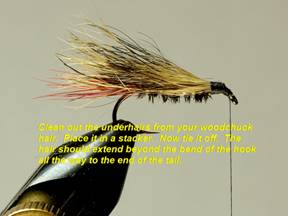 Clean out the underhairs from your woodchuck hair. Place it in a stacker. Now tie it off. The hair should extend beyond the bend of the hook all the way to the end of the tail.
Clean out the underhairs from your woodchuck hair. Place it in a stacker. Now tie it off. The hair should extend beyond the bend of the hook all the way to the end of the tail.
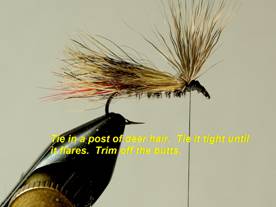 Tie in a post of deer hair. Tie it right until it flares. Trim off the butts.
Tie in a post of deer hair. Tie it right until it flares. Trim off the butts.
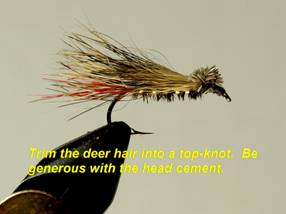 Trim the deer hair into a top-knot. Be generous with the head cement.
Trim the deer hair into a top-knot. Be generous with the head cement.
Tying the pattern is pretty straight forward. When tying in the over body if a little yellow shows through, that’s OK. Since most of the underbody doesn’t show through --- I usually substitute the wool with a poly dubbing or anything that floats better. I also prefer to tie mine on a lighter hook --- I use a Mustad #94833.
For more great info, check out:
Beginning Fly Tying | Intermediate Fly Tying | Advanced Fly Tying.
